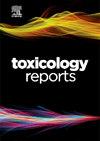Virtual screening, in silico pharmacokinetic and toxicity profiling of colchicine-based inhibitors of estrogen receptor of breast cancer
Q1 Environmental Science
引用次数: 0
Abstract
The declining efficacies of existing drugs against estrogen receptor positive (ER+) breast cancer due to multidrug resistance, acute toxicities, and poor pharmacokinetic properties has necessitated the discovery of newer ones. In this study, colchicine analogues with proven in vitro activities against breast cancer cells were screened against estrogen receptor alpha (ERα) via molecular docking simulations to identify some promising drug candidates. The identified ligands were further subjected to MM/GBSA calculations to ascertain their solvation-dependent Gibb’s free energy of binding (∆GB). Three most promising ligands (MPLs); 12, 16, and 21 with ∆GB values of − 40.37, − 40.31, and − 40.26 kcal/mol, respectively, were identified. When compared with tamoxifen (standard drug) whose ∆GB value is − 38.66 kcal/mol, the MPLs appear more potent. The kinetic stabilities of 12, 16, and 21 were confirmed by DFT (B3LYP/6-31G*) calculations and the time-dependent thermodynamic stabilities of their complexes with ERα were established by molecular dynamic simulations. In addition, the MPLs display positive pharmacokinetic and toxicity profiles and could be excellent sources of potent and non-toxic drug candidates against ER+ breast carcinoma.
基于秋水仙碱的乳腺癌雌激素受体抑制剂的计算机虚拟筛选、药代动力学和毒性分析
由于多药耐药、急性毒性和药代动力学特性差,现有药物对雌激素受体阳性(ER+)乳腺癌的疗效不断下降,因此有必要发现新的药物。在本研究中,我们通过分子对接模拟筛选了秋水仙碱类似物对雌激素受体α (ERα)的体外抗乳腺癌活性,以确定一些有前景的候选药物。确定的配体进一步进行MM/GBSA计算,以确定它们的溶剂依赖性吉布自由结合能(∆GB)。三种最有前途的配体(MPLs);12、16、21的∆GB值分别为- 40.37、- 40.31、- 40.26 kcal/mol。与标准药物他莫昔芬(∆GB值为- 38.66 kcal/mol)相比,其MPLs效果更明显。通过DFT (B3LYP/6-31G*)计算证实了12、16和21的动力学稳定性,并通过分子动力学模拟确定了它们与ERα配合物的热力学稳定性。此外,MPLs显示出积极的药代动力学和毒性谱,可能是抗ER+乳腺癌的有效和无毒候选药物的极好来源。
本文章由计算机程序翻译,如有差异,请以英文原文为准。
求助全文
约1分钟内获得全文
求助全文
来源期刊

Toxicology Reports
Environmental Science-Health, Toxicology and Mutagenesis
CiteScore
7.60
自引率
0.00%
发文量
228
审稿时长
11 weeks
 求助内容:
求助内容: 应助结果提醒方式:
应助结果提醒方式:


